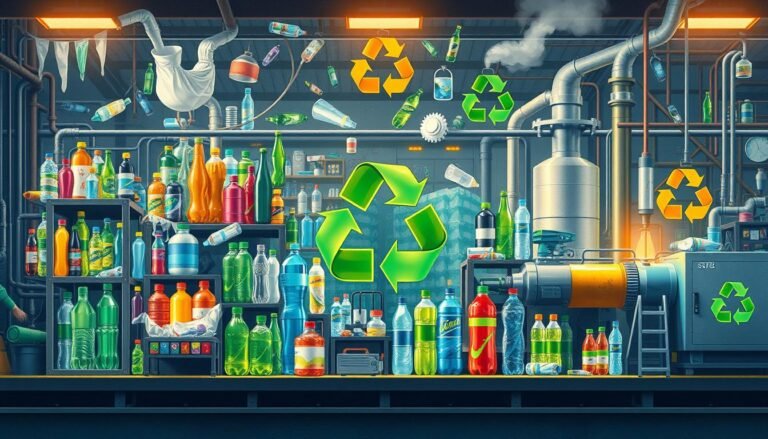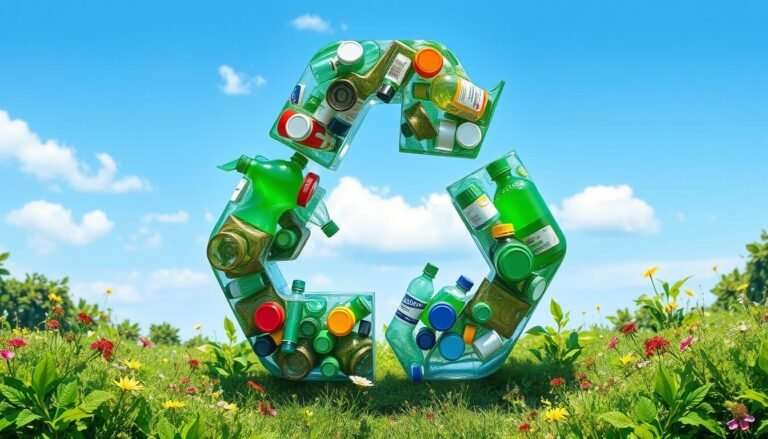Make some changes to the world environment
-
Building 3, Wanyang Innovation City, Langxia Street, Yuyao City, Zhejiang Province
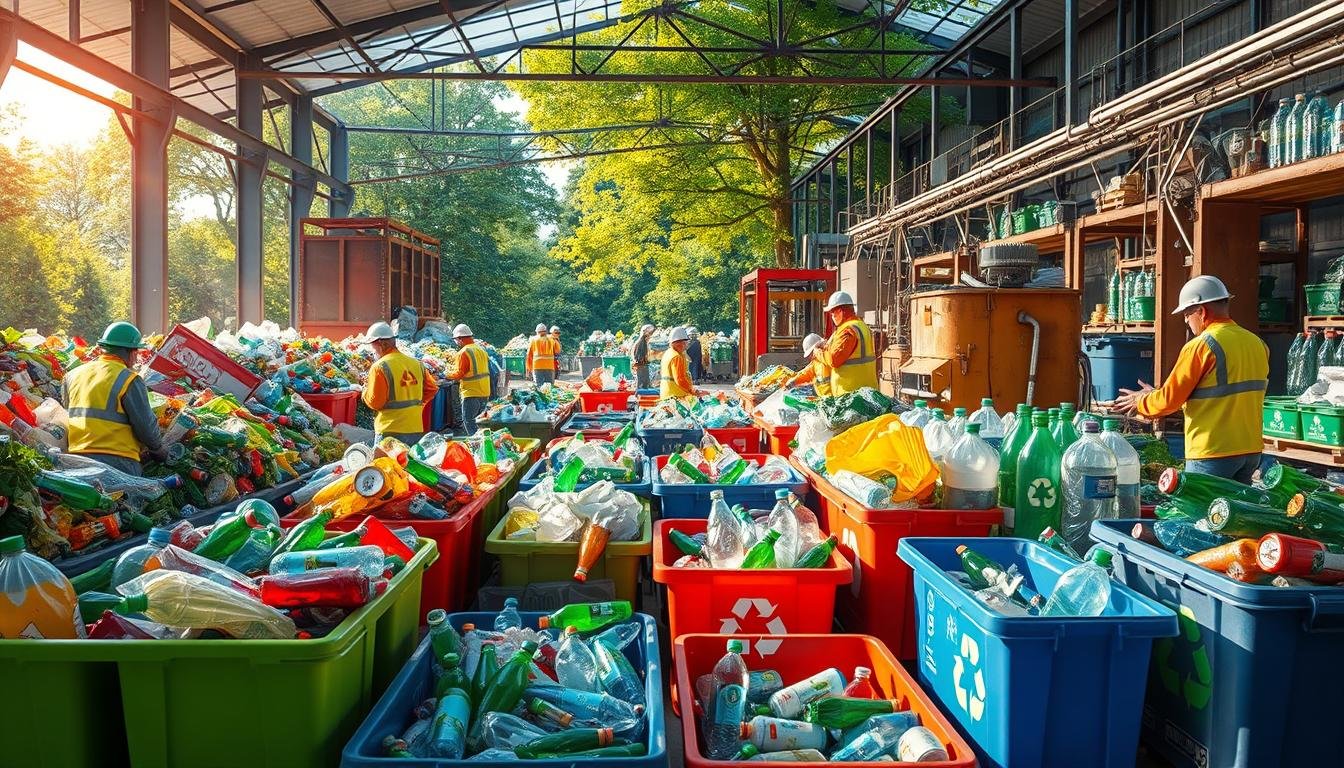
Recycle Plastic Efficiently: A Simple How-To Guide
Ever wondered why recycling plastic is heavily promoted in your area? With plastic waste concerns rising, recycling right has become key for keeping our planet clean. This guide offers tips and insights on identifying and recycling materials properly, whether at home or in your community.
According to the OECD, plastic waste is expected to triple by 2060. Yet, recycling might only increase a little. It’s urgent that we act now1. By recycling correctly, we lessen the environmental harm of plastic waste and boost worldwide sustainable waste efforts. Learning and using better recycling methods can create a big change.
Find out the role of recycling PVC plastic in making the environment cleaner. Our detailed guide gives you the know-how for impactful recycling.
Key Takeaways
- Proper plastic recycling is crucial for reducing environmental impact and promoting sustainable waste management.
- Understanding recyclable materials can significantly enhance recycling efficiency.
- Recycling rates are low globally, but informed individuals can make a difference.
- Organizing and processing recyclables at home contributes to community efforts.
- Collective action from individuals, businesses, and governments is required for sustainable plastic recycling practices.
Globally, only about 10% of plastic packaging is recycled, with rates differing by country1. By following eco-friendly recycling advice and acknowledging the importance of efficient recycling, we can aim for a greener future.
Understanding the Importance of Recycling Plastic
Plastic waste severely harms our environment. It leads to destroyed habitats, endangers wildlife, and pollutes our rivers and oceans. Recycling plastic greatly helps our planet. It keeps trash out of landfills and the sea. Learning about recycling and adopting green habits can reduce these harmful effects.
The Environmental Impact of Plastic Waste
In 2018, plastics made up over 12 percent of America’s waste, a huge jump from less than one percent in 19602. The spike in bottled water sales, from 8.45 billion gallons in 2009 to 14.4 billion in 2019, makes the plastic problem worse2. However, recycling plastic has big environmental benefits. For example, recycling a ton of plastic saves 7.4 cubic yards of landfill space and uses much less energy than making new plastic2.
Case Studies and Current Statistics
Today, more companies and people recycle, showing a shift towards sustainable living3. Recycled plastics are processed at special facilities, using advanced technology to sort and clean them3. Yet, only 4.4 percent of plastic waste was recycled in the U.S. in 2018, pointing to a need for better recycling programs2.
Recycling involves shredding plastic into small bits, then melting and forming new pellets3. These pellets are turned into new products. For recycling to work well, everyone from the public to big companies must work together3.
Types of Plastic and Their Recycling Potential
It’s important to know about the various plastics and how they can be recycled. PET bottles are the most recycled plastic worldwide4. PET is strong and clear. About 31% of it gets recycled in the US, with Europe at 52%5.
HDPE is another common plastic that’s easy to recycle4. It’s second only to PET because many places accept it for recycling5. PVC, however, is the third-most produced plastic but is hard to recycle due to toxic additives4.
LDPE is used in plastic wraps but rarely recycled through curbside programs, despite being safe for food4. PP and PS both have their own recycling issues. PP is widely made but hardly recycled54. PS use is dropping due to recycling challenges and bans in food service5.
Plastic number 7, or polycarbonate, is tough. It’s used in durable goods like shatter-resistant glass54. But, it’s hardly ever recycled because of the risk of bisphenol A leaking4.
Knowing the resin codes helps a lot in recycling better. When we identify and separate plastics correctly, we boost recycling4. This cuts down on pollution and supports sustainability.
How to Identify Recyclable Plastic from Home
To find recyclable plastics at home, look for recycling symbols and resin codes usually on the bottom of containers. Knowing these codes is key to figuring out if you can recycle the item and how to do it. These symbols show different types of plastics, numbered 1 to 7.
Plastic Identification Codes and Symbols
Resin codes help us tell apart different plastics and their ability to be recycled. Polyethylene terephthalate, or PETE, is code #1. It’s recycled about 20% of the time and is in high demand by companies6. High-density polyethylene, or HDPE, is code #2. It’s accepted by most curbside recycling programs and can be turned into many products6. Learning these codes makes sorting recyclables easier.
Common Household Plastics That Can Be Recycled
Some everyday items can be recycled easily if we know what to look for. These include:
- Water bottles (code #1 – PET): These are highly recyclable, with some places recycling more than half7.
- Milk jugs (code #2 – HDPE): In the US, about 30% of HDPE bottles are recycled, making them quite common in recycling bins7.
- Detergent containers (code #2 – HDPE): Just like milk jugs, these are often recycled.
Other plastics, like polypropylene (PP – code #5), are accepted by more recyclers nowadays, yet less than 3% get recycled in the US7. Plastics such as polystyrene (PS – code #6) and mixed plastics (code #7) usually aren’t picked up in curbside programs6. Knowing what the recycling symbols mean helps us recycle better at home.
How can I recycle plastic at Home and in the Community
To recycle effectively at home, start by separating your trash. Learn the numbers 1 to 7 on plastics to know what’s recyclable. For example, Type 1 PET (like water bottles) and Type 2 HDPE (milk jugs) can be recycled at home with ease8. But, remember, dirty items can spoil a whole recycling batch. So, clean your food containers, avoid bagging recyclables, and take off any parts that can’t be recycled8.
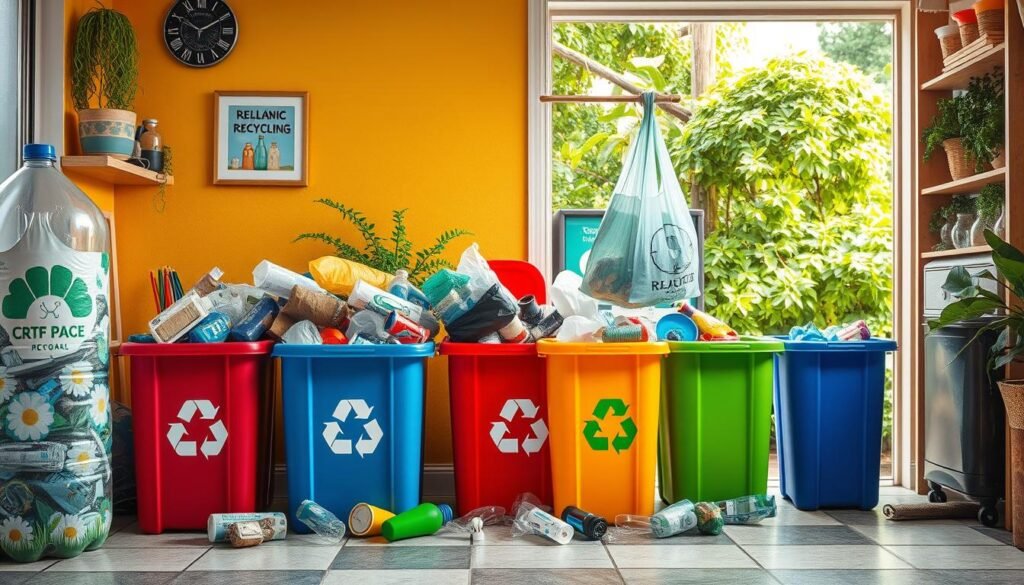
In the community, joining local programs helps cut down on plastic waste. Some places offer curbside pickup, making it easy to recycle from home. Community events like “Give Away Days” encourage sharing and reusing items instead of throwing them away9.
Special recycling centers are key for plastics that are hard to recycle. They handle things like Type 3 PVC (found in shampoo bottles), Type 4 LDPE (used in baskets), and Type 6 PS (like foam cups)8. Projects that use technology, such as solar power for “ecoprinting,” show what communities can do globally10.
Pushing for strong recycling programs in your community can make a big difference. Organizing clean-ups or advocating for better policies helps improve recycling’s reach. Getting involved with systems that handle many types of recyclables supports sustainability8.
In short, recycling at home and in our communities takes effort from everyone. By recycling properly at home and supporting local programs, we can greatly reduce plastic waste. Let’s work together for better recycling systems and take part in making our communities more sustainable.
For more tips on ending plastic waste, check out this guide on effective plastic recycling.
Steps to Prepare Plastics for Recycling
Getting plastics ready for recycling is crucial in protecting our environment. This process ensures we get the most out of recycling. It involves cleaning and sorting recyclables properly.
Cleaning and Sorting Plastics
The first key step is to clean the recyclables well. We must remove all food and dirt to keep the quality high. As we clean, sorting by type and color is equally important. PETE and HDPE plastics, for example, need different recycling methods11. Sorting correctly ensures each plastic is recycled the right way, which is essential due to their different recycling needs12.
Removing Labels and Stickers
Taking off labels and stickers is a crucial but often missed step. These can mess up the recycling process, especially in plastics like PET, which is easier to recycle than some others11. By removing them, we help keep the recycling process clean and make better recycled products.
By cleaning and sorting carefully, we make recycling more efficient and successful. As recycling technology gets better, we can recycle more and reduce harm to our planet12.
Local Recycling Programs: What You Need to Know
It’s key to know how local recycling works to recycle right and follow the rules. Different areas accept different types of stuff, and the way you should throw things away can change. This depends on where you live.
Residential Curbside Recycling Programs
In many places, you can leave recycling at the curb for collection. Often, they’ll pick up plastics, paper, and glass. But, remember, each place has its rules. For example, many places can’t take plastic bags in curbside collection because they might clog the machines. This can stop the whole recycling process and cause a lot of extra work13. Yet, some areas do take them, so it’s wise to check what your local program allows14.
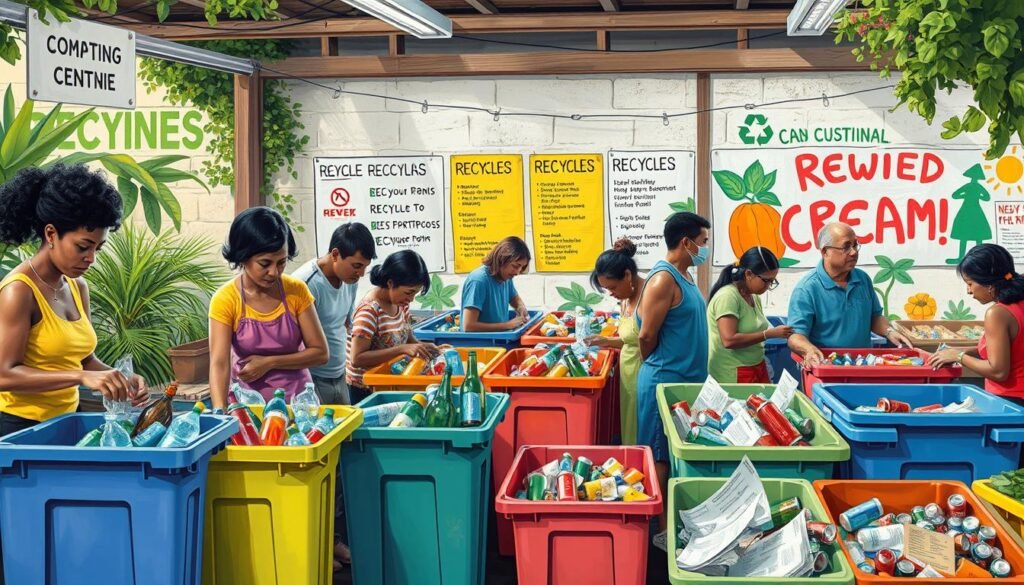
Specialized Recycling Facilities
Besides curbside collection, cities might have special spots for recycling things curbside can’t take. This includes stuff like electronics, dangerous materials, or big plastic items. Using these places helps keep the wrong stuff out of regular recycling15. It helps us recycle better and protects our planet.
In 2018, the U.S. made almost 35.7 million tons of plastics, but less than 9% was recycled15. This shows why we need regular and special recycling places to do better. For things like plastic bags, many communities have drop-off spots, like in some stores, to recycle them properly14.
Recycling Plastics that Require Specialized Facilities
Recycling *difficult-to-recycle plastics* needs centers with the right technology. Plastics such as polystyrene, or Styrofoam, are tough to break down16. They can stay in landfills for over 500 years, causing long-term pollution16.
In 2021, the U.S. threw away 51 million tons of plastic. Sadly, only 2.4 million tons were recycled. This shows we must do better in recycling16. Foam products like cups and egg cartons can’t be recycled in regular bins17. They need special facilities17.
Flexible packages, like snack bags, are hard to recycle too17. They’re made of different materials mixed together. To fix this, the U.S. is building more chemical recycling places16. By 2022, there will be 8, plus 2 more being built, and plans for another 1216.
Big plastic items, like buckets, also need special recycling17. They can’t go with regular recycling. This calls for using special places that can handle them17. It’s crucial we find better ways to recycle these tough plastics17.
Alternatives to Plastic: Reduce and Reuse
Reducing plastic use and choosing sustainable options help fight plastic pollution. By using reusable items, we cut down on our environmental impact.
Using Reusable Bags and Containers
Switching to reusable bags and containers is a great way to use less plastic. Natural fabrics like organic cotton, wool, or bamboo, make great bag and container materials. They’re not only strong but also eco-friendly, not shedding plastic bits when washed, and they last longer than plastic18.
Platinum silicone, made from sand, is also a top choice for keeping food. It’s stretchy, tough, and doesn’t contain plastic fillers, ideal for those wanting to use less plastic18. Using reusable water bottles too cuts back on single-use plastic bottles, helping to reduce nano-plastics19.
Opting for Plastic Alternatives in Everyday Life
Seeking out plastic substitutes can greatly lower plastic trash. Bamboo, quick to grow and compostable, is perfect for making things like tableware and straws18. In Poland, pressed hay replaces plastic in egg cartons, a smart eco-friendly choice18. And mushroom packaging is a growing favorite for compostable Styrofoam alternatives18.
In Thailand, supermarkets are turning to banana leaves and bamboo to replace plastic packaging18. Seaweed packaging, both edible and biodegradable, is another exciting option showing how natural resources can lessen plastic use18.
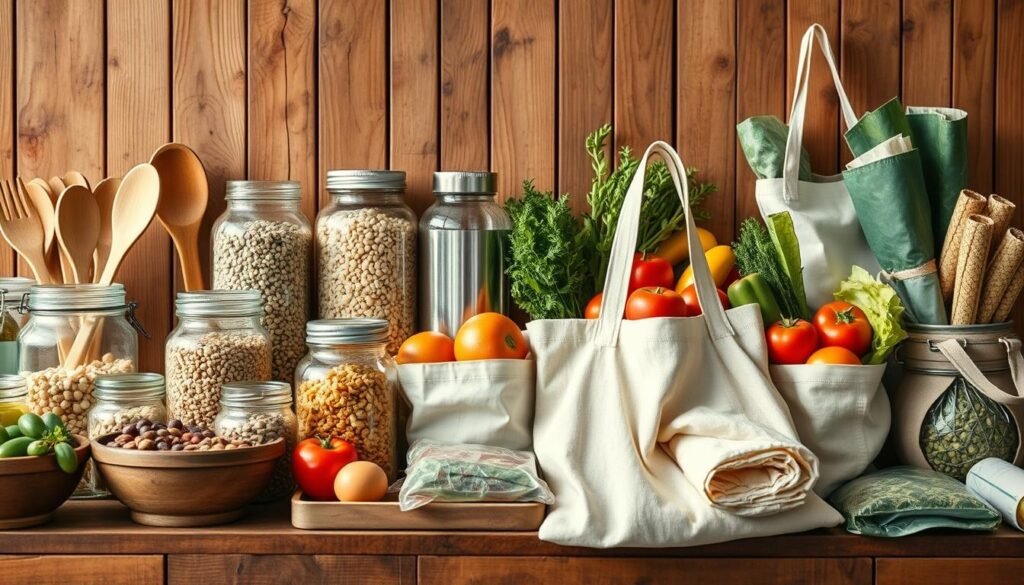
Adopting these plastic substitutes not only aids in protecting our planet but also encourages a more sustainable lifestyle. To learn more about cutting plastic waste, click here18. Plus, getting into HDPE plastic recycling adds to our sustainability efforts. Discover more on these innovations here19.
Understanding the Recycling Process
The process of recycling plastic is a complex one. It changes waste plastics into usable materials. Knowing how this works helps us recycle better and protect our planet.
Stages of Recycling Plastic
Recycling plastic starts with gathering it from homes and places like drop-off centers. We also get plastic from places that pay you to return it20. These plastics are then taken to facilities where they are prepared for recycling.
Sorting, Washing, and Extrusion
First, the plastics are sorted. This step gets rid of anything that might be mixed in and divides the plastics by type. Next, they are cleaned to remove stuff like labels and dirt21. Cleaning is key to getting the plastic ready for the next stage.
The last step is called extrusion. Here, the clean plastic is melted down and made into pellets. These pellets are used to make new plastic items. This closing of the loop is vital for recycling22. It shows how old plastic can be used to make useful things like benches and bridges20.
Challenges and Solutions in Plastic Recycling
Recycling plastic comes with big challenges like tech limits, different rules, and not enough people knowing about it. Every year, the world makes about 260 million metric tonnes of plastic. This has been increasing by 9% annually23. Even with so much plastic, only 8% gets recycled in the U.S24. To fix this, we need better recycling tech and clearer rules.
Recycling tech varies a lot around the world. For example, Europe has different rates of recycling and turning waste to energy23. By inventing better ways to recycle chemically, we can manage plastic waste better. Also, having the same rules everywhere will help speed up recycling.
It’s also important for people to know more about recycling. In 2017, the U.S. managed to recycle or compost 94.2 million tons of waste. Yet, that was only 35% of all waste created24. We need to get everyone involved and teach them how to recycle better. This is key to handling plastic waste in a good way for the planet.
A lot of plastic waste comes from stuff we only use once. Back in 2000, the UK used 4450 ktonnes of plastic, and 37% was for packaging23. With more people helping out and new recycling ideas, we can tackle these issues well.
To wrap up, beating recycling challenges needs new tech, better rules, and getting everyone involved. By combining these approaches, we can cut down on plastic waste and save resources. For cool recycling ideas, check out our guide on PS plastic recycling solutions for a better23 future. By working together, we can make a big difference in managing plastic waste worldwide.
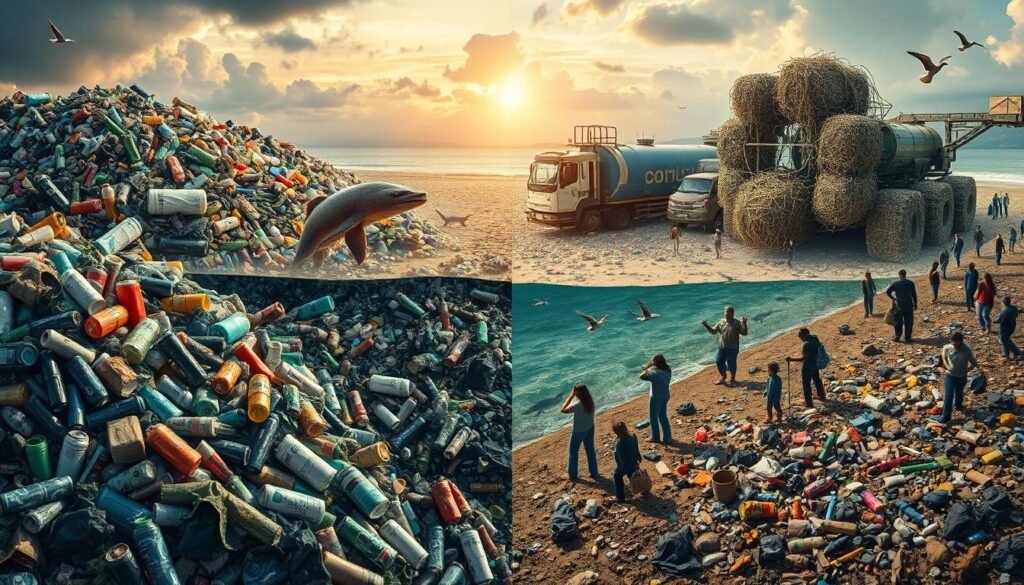
Things You Shouldn’t Recycle and What to Do with Them
It’s key to throw away stuff we can’t recycle in the right way. This keeps recycling working well and protects our planet. Knowing what we can’t recycle and dealing with it correctly cuts down on waste mix-ups and makes recycling more effective.
Non-recyclable Plastics
Many plastics, like squeeze bottles, coffee cup lids, and to-go boxes, can’t be recycled. This includes plastic items labeled 3 to 7 and things like yogurt cups and straws. Things like styrofoam, plastic silverware, cups with special coatings, chip bags, and some electronics25 also can’t be recycled. With only 19% of materials globally recycled, we must not put these non-recyclable items in the recycling bin26.
Don’t put electronics in your recycling bin because they can be dangerous. It’s better to take them to places that recycle electronics safely25. Recycling the right way can create lots of jobs. In fact, in the U.S., recycling creates over 680,000 jobs and brings in about $37.8 billion in wages each year25.
Local Disposal Options
Knowing what your community’s recycling rules are can really help. Many places have special spots or programs for things you can’t recycle at the curb. Like, electronics need to go to special spots so they don’t harm the environment25.
Local recycling centers can give you tips on how to dispose of non-recyclables. For more info on recycling’s benefits, like reducing pollution and saving resources, check out this guide to sustainable practices.
Conclusion
Recycling plastic right is crucial for many reasons. It helps the environment, economy, and our communities. This guide highlights the need to recycle correctly, whether alone or together.
Recycling starts by collecting used plastics. Then, they are taken to facilities for sorting, washing, and shredding27. This process removes dirt and turns the plastic into new pellets27. It covers different plastics, like nylons and polyethylene. This shows how we can turn waste into valuable items27.
Recycling is also good for our economy and the Earth. It creates jobs and lowers the damage from plastic waste. This includes less pollution and protecting animals27. The recycling world is getting better. New methods are making plastic film recycling more efficient. Businesses see recycling as better than using landfills28. Adopting these practices means a cleaner planet for future generations.


